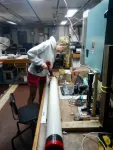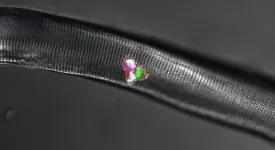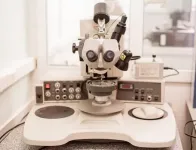Retroviruses are re-writing the koala genome and causing cancer
2021-02-26
(Press-News.org) The koala retrovirus (KoRV) is a virus which, like other retroviruses such as HIV, inserts itself into the DNA of an infected cell. At some point in the past 50,000 years, KoRV has infected the egg or sperm cells of koalas, leading to offspring that carry the retrovirus in every cell in their body. The entire koala population of Queensland and New South Wales in Australia now carry copies of KoRV in their genome. All animals, including humans, have gone through similar "germ line" infections by retroviruses at some point in their evolutionary history and contain many ancient retroviruses in their genomes. These retroviruses have, over millions of years, mutated into degraded, inactive forms that are no longer harmful to the host. Since in most animal species this process occurred millions of years ago, the immediate health effects on the host at that time are unknown but it has been suspected for some time that the invasion of a genome by a retrovirus may have considerable detrimental health effects. The koala is at a very early stage of this process when the retrovirus is still active and these health effects can be studied.
Since retroviruses can cause cancer, it was thought that there is a link between KoRV and the high frequency of lymphoma, leukemia and other cancers in koalas from northern Australia. To investigate this link, scientists at the Leibniz-IZW sequenced DNA from wild koalas suffering from cancer. This allowed them to accurately detect the number of copies of KoRV in the koala genomes and identify the precise locations where the retrovirus had inserted its DNA. By comparing this information between healthy and tumour tissues in single koalas, and by comparing insertion sites between koala individuals, they found multiple links between KoRV and genes known to be involved in the kind of cancers to which koalas are prone.
"Each koala carries around 80 - 100 inherited copies of KoRV in its genome. The genomic locations of most of these are not shared between koalas, indicating a rapid expansion and accumulation of KoRV copies in the population. Each time a retrovirus copies and re-inserts itself into the genome, it causes a mutation, potentially disrupting gene expression, which could be detrimental to the host," says Prof Alex Greenwood, Head of Department of Wildlife Diseases at the Leibniz-IZW. This means that by frequently copying itself to new locations in the genome, KoRV is currently conferring a high mutational load on the koala population. Tumour tissues contain many new copies of KoRV, indicating that KoRV is more active in tumour cells. These copies generally were located close to genes associated with cancer. New KoRV insertions in tumour tissues affected the expression of genes in their vicinity. Such changes in gene expression associated with cancer can cause increased cell growth and proliferation, which leads to tumours. Although other factors may also contribute to cancer in koalas, the mutational burden from KoRV likely increases the frequency of cells becoming cancerous and may shorten the time for cancer to develop.
In one koala, a copy of KoRV was found that had incorporated an entire cancer-related gene from the koala genome into its DNA sequence. This greatly increased expression of this gene and most likely caused cancer in this particular koala. If this mutated virus is transmissible, it would be of grave concern for koala conservation efforts. Comparing the genomic location of KoRVs between koalas also suggests that KoRV may predispose related koalas to particular tumours, with koalas sharing KoRV insertions in specific cancer-related genes suffering from similar types of cancer which they can pass on to their offspring. Across all koalas studied, there were "hot spots" in the genome where KoRV frequently inserts itself. These hot spots were also located in proximity to genes associated with cancer. "In summary then, we find multiple links at the genomic level between cancer-related genes and KoRV, revealing ways in which KoRV underlies the high frequency of cancer in koalas," explains Gayle McEwen, scientist at the Leibniz-IZW.
The results highlight the detrimental health consequences that wildlife species can suffer following germline infection by retroviruses. Germline invasions have been repeatedly experienced during vertebrate evolution and have shaped vertebrate genomes, including the lineage leading to modern humans. These were most likely associated with severe detrimental health effects, which must be endured and overcome to ensure species survival. The scientists at the Leibniz-IZW have previously shown that old retroviruses present in the koala genome aid the rapid degradation of KoRV. The koala finds itself in a race to survive the effects of KoRV long enough for the virus to be degraded. Considering the many threats to koalas, it is a race they need to win.
INFORMATION:
Publication
McEwen GK, Alquezar-Planas DE, Dayaram A, Gillett A, Tarlinton R, Mongan N, Chappell KJ, Henning J, Tan M, Timms P, Young PR, Roca AL, Greenwood AD (2021): Retroviral integrations contribute to elevated host cancer rates during germline invasion. NAT COMM.
doi:10.1038/s41467-021-21612-7.
Contact
Leibniz Institute for Zoo and Wildlife Research (IZW)
in the Forschungsverbund Berlin e.V.
Alfred-Kowalke-Str. 17
10315 Berlin
Germany
Alex D Greenwood
(greenwood@izw-berlin.de)
Head Department of Wildlife Diseases
Tel. +49 (0)30 51 68 255
Gayle K McEwen
(mcewen@izw-berlin.de)
Scientist
Tel. +49 (0)30 51 68 464
Steven Seet
(seet@izw-berlin.de)
Head Science Communication
Tel.: +49 (0)177 857 26 73
[Attachments] See images for this press release:

ELSE PRESS RELEASES FROM THIS DATE:
2021-02-26
NARRAGANSETT, R.I. - February 26, 2021 - A team of researchers from the University of Rhode Island's END ...
2021-02-26
When a muscle grows, because its owner is still growing too or has started exercising regularly, some of the stem cells in this muscle develop into new muscle cells. The same thing happens when an injured muscle starts to heal. At the same time, however, the muscle stem cells must produce further stem cells - i.e., renew themselves - as their supply would otherwise be depleted very quickly. This requires that the cells involved in muscle growth communicate with each other.
Muscle growth is regulated by the Notch signaling pathway
Two years ago, a team of researchers led by Professor Carmen Birchmeier, head of the Developmental Biology/Signal Transduction ...
2021-02-26
A new study shows that a widespread decline in abundance of emergent insects - whose immature stages develop in lakes and streams while the adults live on land - can help to explain the alarming decline in abundance and diversity of aerial insectivorous birds (i.e. preying on flying insects) across the USA. In turn, the decline in emergent insects appears to be driven by human disturbance and pollution of water bodies, especially in streams. This study, published in END ...
2021-02-26
Who would have thought that a small basic compound like vitamin B6 in the banana or fish you had this morning may be key to your body's robust response against COVID-19?
Studies have so far explored the benefits of vitamins D and C and minerals like zinc and magnesium in fortifying immune response against COVID-19. But research on vitamin B6 has been mostly missing. Food scientist END ...
2021-02-26
HDL cholesterol (high-density lipoprotein cholesterol) or good cholesterol is associated with a decreased risk of cardiovascular disease as it transports cholesterol deposited in the arteries to the liver to be eliminated. This contrasts with the so-called bad cholesterol, LDL (low-density lipoprotein cholesterol), which causes cholesterol to accumulate in the arteries and increases cardiovascular risk. Although drugs that lower bad cholesterol reduce cardiovascular risk, those that raise good cholesterol have not proven effective in reducing the risk of heart disease. This paradox has called into question the ...
2021-02-26
Whilst the nation has taken to washing its hands regularly since the start of the pandemic, other individual behaviours, such as cleaning and disinfecting surfaces or social distancing within the home, have proved harder to stick, say the researchers behind the behaviour change website 'Germ Defence'.
In their new study, published today (Friday 26 February 2021) in the Journal of Medical Internet Research, psychologists from the universities of Bath, Bristol and Southampton, warn of the continuing risks of household transmission of COVID-19 and the ongoing importance of breaking chains of transmission now and in the future.
Their research analysed user data of the ...
2021-02-26
Treating critically ill COVID-19 patients with drugs typically used for rheumatoid arthritis may significantly improve survival, a landmark study has found.
The findings, which were announced in January and have now been peer-reviewed and published in the New England Journal of Medicine, come from the REMAP-CAP trial, which evaluates the effect of treatments on a combination of survival and length of time patients need support in an intensive care unit (ICU).
Initial findings reported in November showed that tocilizumab, a drug used to treat arthritis, was likely to improve outcomes among critically ill COVID-19 ...
2021-02-25
Clinical research requires that data be mined for insights. Machine learning, which develops algorithms to find patterns, has difficulty doing this with data related to health records because this type of information is neither static nor regularly collected. A new study developed a transparent and reproducible machine learning tool to facilitate analysis of health information. The tool can be used in clinical forecasting, which can predict trends as well as outcomes in individual patients.
The study, by a researcher at Carnegie Mellon University (CMU), appears in Proceedings of Machine Learning Research.
"Temporal Learning Lite, or TL-Lite, is a visualization and forecasting tool to ...
2021-02-25
Physicists from Russia, Chile, Brazil, Spain, and the UK, have studied how the magnetic properties change in 3D nanowires, promising materials for various magnetic applications, depending on the shape of their cross-section. Particularly, they more deeply probed into the Walker breakdown phenomenon, on the understanding of which the success of the implementation of the future electronics devices depends. The research outcome appears in Scientific Reports.
The cross-sectional geometry of a three-dimensional nanowire affects the domain wall dynamics and therefore is crucial for their control. In turn, managing the DW dynamics under various external conditions is necessary in order to realize the future electronics and computing devices, operating on new physical principles. ...
2021-02-25
Born in food web ecology, the concept of trophic levels -- the hierarchy of who eats who in the natural world -- is an elegant way to understand how biomass and energy move through a natural system. It's only natural that the idea found its way into the realm of aquaculture, where marine and freshwater farmers try to maximize their product with efficient inputs.
"It's often used as a measure of how sustainable it is to harvest or consume that species," said Rich Cottrell(link is external), a postdoctoral researcher at UC Santa Barbara's National Center for Ecological Analysis & Synthesis (NCEAS). As plants (level 1) become food to plant eaters (level 2), who in turn are consumed by carnivores (level 3) and so on, the amount of energy ...
LAST 30 PRESS RELEASES:
[Press-News.org] Retroviruses are re-writing the koala genome and causing cancer



